
Concept explainers
Predict the products of the following reactions. Don’t worry about the size of the molecule; concentrate on the
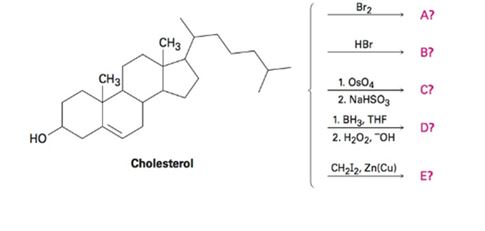
a)
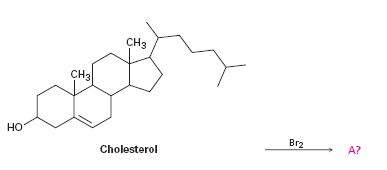
Interpretation:
To predict the product formed when cholesterol reacts with bromine.
Concept introduction:
The reaction of halogens to alkenes occurs with anti stereochemistry, that is, the two halogen atoms come from opposite faces of the double bond- one from top face and other from bottom face. In the first step the addition of halogen to the double bond in the alkenes results in the formation of a cyclic halonium ion with the simultaneous elimination of a halide ion. The large halonium ion shields one side of the molecule. Hence the attack of the halide ion occurs from the opposite, unshielded side to yield the trans product.
To predict:
The product formed when cholesterol reacts with bromine.
Answer to Problem 48AP
The product formed when cholesterol reacts with bromine.

Explanation of Solution
In the first step, the addition of bromine to the double bond in cholesterol results in the formation of a cyclic bromonium ion with the elimination of a bromide ion. In the second step the bromide ion attacks the bromonium ion from the opposite, unshielded side to yield a dibromo derivative.
The product formed when cholesterol reacts with bromine.
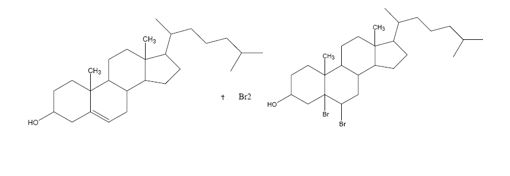
b)
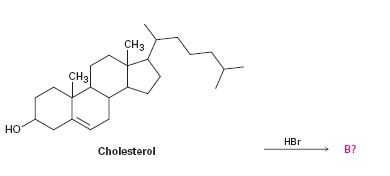
Interpretation:
To predict the product formed when cholesterol reacts with HBr.
Concept introduction:
The addition of hydrogen halides to alkenes takes place through the formation of a carbocation intermediate by the attack of the π electrons in the double bond on the positively polarized hydrogen of the hydrogen halide. The halogen is eliminated as a halide ion. In the second step, the halide ion reacts with the carbocation to yield the product.
To predict:
The product formed when cholesterol reacts with HBr.
Answer to Problem 48AP
The product formed when cholesterol reacts with HBr is

Explanation of Solution
The addition of hydrogen bromide to cholesterol takes place through the formation of a carbocation intermediate by the attack of the π electrons in the double bond on the positively polarized hydrogen of the hydrogen bromide. The bromine is eliminated as bromide ion which reacts in the second step with the carbocation to yield the product.
The product formed when cholesterol reacts with HBr is

c)
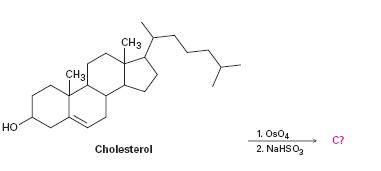
Interpretation:
To predict the product formed when cholesterol reacts first with OsO4 and then with NaHSO3.
Concept introduction:
Hydroxylation of double bonds can be carried out directly by treating the alkene with osmium tetroxide, OsO4, in the presence of N-phenylmorpholine N-oxide. The reaction occurs with syn stereochemistry through the formation of a cyclic intermediate, called osmate, formed by the addition of OsO4 to the alkene in a single step. The cyclic osmate is then cleaved to give the cis-1, 2-diol by treatment with NaHSO3.
To predict:
The product formed when cholesterol reacts with first with OsO4 and then with NaHSO3.
Answer to Problem 48AP
The product formed when cholesterol reacts with first with OsO4 and then with NaHSO3 is
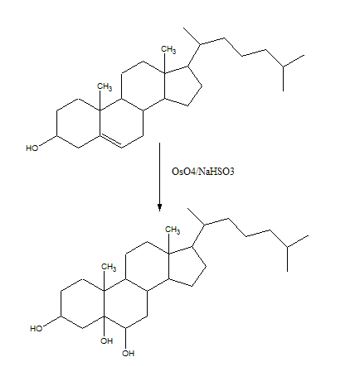
Explanation of Solution
The addition of OsO4 to the double bond in cholesterol takes place in a single step to give an osmate. The cyclic osmate when cleaved by treatment with NaHSO3 gives the cis-diol as the product.
The product formed when cholesterol reacts with first with OsO4 and then with NaHSO3 is
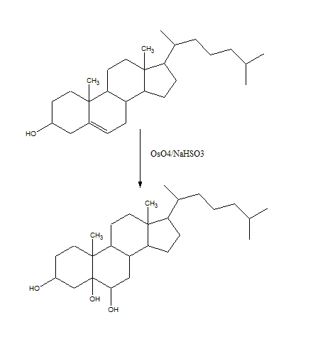
d)
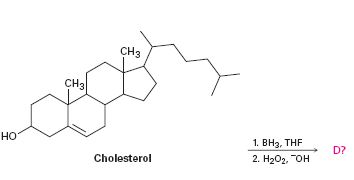
Interpretation:
To predict the product formed when cholesterol reacts first with BH3, THF and then with H2O2, OH-.
Concept introduction:
The hydroboration-oxidation reaction takes place with syn stereochemistry and results in a non-Markovnikov addition of water to the double bond in the alkene. The resulting product has the hydroxyl group on the less highly substituted carbon.
To predict:
The product formed when cholesterol reacts with first with BH3, THF and then with H2O2, OH-.
Answer to Problem 48AP
The product formed when cholesterol reacts with first with BH3, THF and then with H2O2, OH- is
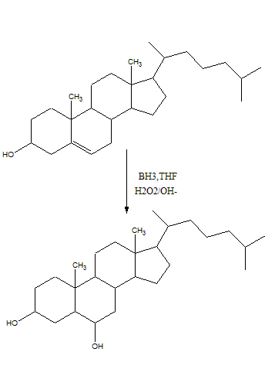
Explanation of Solution
During hydroboration, the addition of B-H to the double bond takes place with a syn stereochemistry. The boron atom being bigger than hydrogen gets attached to the less highly substituted carbon atom (less steric crowding). During the oxidation step, the boron is replaced by an –OH group with the same stereochemistry.
The product formed when cholesterol reacts with first with BH3, THF and then with H2O2, OH- is
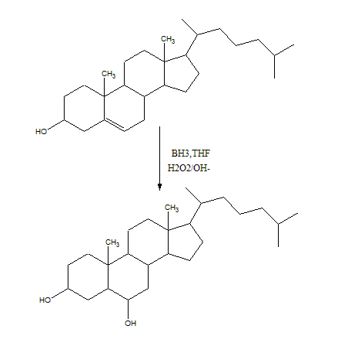
e)
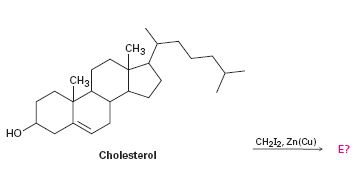
Interpretation:
To predict the product formed when cholesterol reacts with CH2I2 in the presence of Zn (Cu).
Concept introduction:
The reaction given is an example of Simmons-Smith reaction. When CH2I2 is treated with Zn/Cu couple, iodomethylzinc iodide, ICH2ZnI, is formed. This ICH2ZnI transfers a CH2 group to the double bond in alkene to form a cyclopropane ring in the product.
To predict:
The product formed when cholesterol reacts with CH2I2 in the presence of Zn (Cu).
Answer to Problem 48AP
The product formed when cholesterol reacts with CH2I2 in the presence of Zn (Cu) is
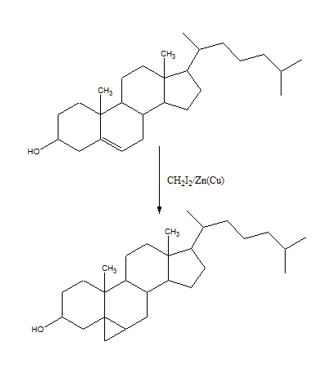
Explanation of Solution
When CH2I2 is treated with Zn/Cu couple, iodomethylzinc iodide, ICH2ZnI, is formed. This ICH2ZnI transfers a CH2 group to the double bond in cholesterol to form a cyclopropane ring in the product.
The product formed when cholesterol reacts with CH2I2 in the presence of Zn (Cu) is
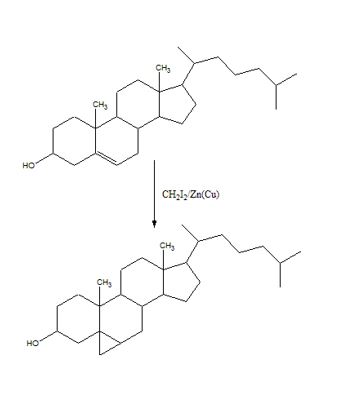
Want to see more full solutions like this?
Chapter 8 Solutions
Student Value Bundle: Organic Chemistry, + OWLv2 with Student Solutions Manual eBook, 4 terms (24 months) Printed Access Card (NEW!!)
- Identifying the major species in weak acid or weak base equilibria Your answer is incorrect. • Row 2: Your answer is incorrect. • Row 3: Your answer is incorrect. • Row 6: Your answer is incorrect. 0/5 The preparations of two aqueous solutions are described in the table below. For each solution, write the chemical formulas of the major species present at equilibrium. You can leave out water itself. Write the chemical formulas of the species that will act as acids in the 'acids' row, the formulas of the species that will act as bases in the 'bases' row, and the formulas of the species that will act as neither acids nor bases in the 'other' row. You will find it useful to keep in mind that HF is a weak acid. acids: HF 0.1 mol of NaOH is added to 1.0 L of a 0.7M HF solution. bases: 0.13 mol of HCl is added to 1.0 L of a solution that is 1.0M in both HF and KF. Exponent other: F acids: HF bases: F other: K 1 0,0,... ? 000 18 Ararrow_forwardUsing reaction free energy to predict equilibrium composition Consider the following equilibrium: 2NOCI (g) 2NO (g) + Cl2 (g) AGº =41. kJ Now suppose a reaction vessel is filled with 4.50 atm of nitrosyl chloride (NOCI) and 6.38 atm of chlorine (C12) at 212. °C. Answer the following questions about this system: ? rise Under these conditions, will the pressure of NOCI tend to rise or fall? x10 fall Is it possible to reverse this tendency by adding NO? In other words, if you said the pressure of NOCI will tend to rise, can that be changed to a tendency to fall by adding NO? Similarly, if you said the pressure of NOCI will tend to fall, can that be changed to a tendency to rise by adding NO? yes no If you said the tendency can be reversed in the second question, calculate the minimum pressure of NO needed to reverse it. Round your answer to 2 significant digits. 0.035 atm ✓ G 00. 18 Ararrow_forwardHighlight each glycosidic bond in the molecule below. Then answer the questions in the table under the drawing area. HO- HO- -0 OH OH HO NG HO- HO- OH OH OH OH NG OHarrow_forward
- € + Suppose the molecule in the drawing area below were reacted with H₂ over a platinum catalyst. Edit the molecule to show what would happen to it. That is, turn it into the product of the reaction. Also, write the name of the product molecule under the drawing area. Name: ☐ H C=0 X H- OH HO- H HO- -H CH₂OH ×arrow_forwardDraw the Haworth projection of the disaccharide made by joining D-glucose and D-mannose with a ẞ(1-4) glycosidic bond. If the disaccharide has more than one anomer, you can draw any of them. Click and drag to start drawing a structure. Xarrow_forwardEpoxides can be opened in aqueous acid or aqueous base to produce diols (molecules with two OH groups). In this question, you'll explore the mechanism of epoxide opening in aqueous acid. 2nd attempt Be sure to show all four bonds at stereocenters using hash and wedge lines. 0 0 Draw curved arrows to show how the epoxide reacts with hydronium ion. 100 +1: 1st attempt Feedback Be sure to show all four bonds at stereocenters using hash and wedge lines. See Periodic Table See Hint H A 5 F F Hr See Periodic Table See Hintarrow_forward
- 03 Question (1 point) For the reaction below, draw both of the major organic products. Be sure to consider stereochemistry. > 1. CH₂CH₂MgBr 2. H₂O 3rd attempt Draw all four bonds at chiral centers. Draw all stereoisomers formed. Draw the structures here. e 130 AN H See Periodic Table See Hint P C Brarrow_forwardYou may wish to address the following issues in your response if they are pertinent to the reaction(s) you propose to employ:1) Chemoselectivity (why this functional group and not another?) 2) Regioselectivity (why here and not there?) 3) Stereoselectivity (why this stereoisomer?) 4) Changes in oxidation state. Please make it in detail and draw it out too in what step what happens. Thank you for helping me!arrow_forward1) Chemoselectivity (why this functional group and not another?) 2) Regioselectivity (why here and not there?) 3) Stereoselectivity (why this stereoisomer?) 4) Changes in oxidation state. Everything in detail and draw out and write it.arrow_forward
- Calculating the pH at equivalence of a titration 3/5 Izabella A chemist titrates 120.0 mL of a 0.7191M dimethylamine ((CH3)2NH) solution with 0.5501 M HBr solution at 25 °C. Calculate the pH at equivalence. The pk of dimethylamine is 3.27. Round your answer to 2 decimal places. Note for advanced students: you may assume the total volume of the solution equals the initial volume plus the volume of HBr solution added. pH = ☐ ✓ 18 Ar Boarrow_forwardAlcohols can be synthesized using an acid-catalyzed hydration of an alkene. An alkene is combined with aqueous acid (e.. sulfuric acid in water). The reaction mechanism typically involves a carbocation intermediate. > 3rd attempt 3343 10 8 Draw arrows to show the reaction between the alkene and hydronium ion. that 2nd attempt Feedback 1st attempt تعمال Ju See Periodic Table See Hint F D Ju See Periodic Table See Hintarrow_forwardDraw the simplified curved arrow mechanism for the reaction of acetone and CHgLi to give the major product. 4th attempt Π Draw the simplified curved arrow mechanism T 3rd attempt Feedback Ju See Periodic Table See Hint H -H H -I H F See Periodic Table See Hintarrow_forward
- Chemistry: Matter and ChangeChemistryISBN:9780078746376Author:Dinah Zike, Laurel Dingrando, Nicholas Hainen, Cheryl WistromPublisher:Glencoe/McGraw-Hill School Pub Co
